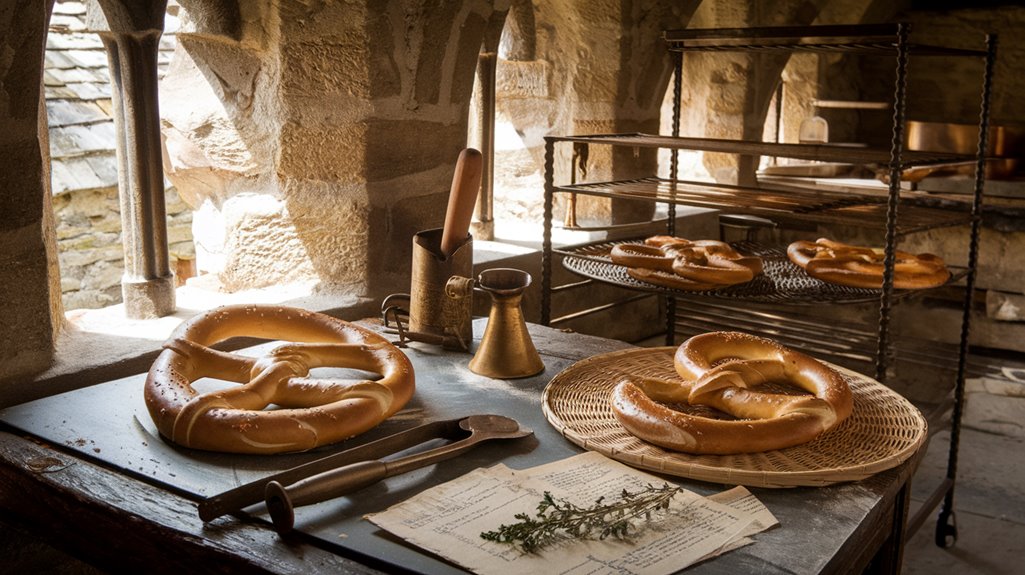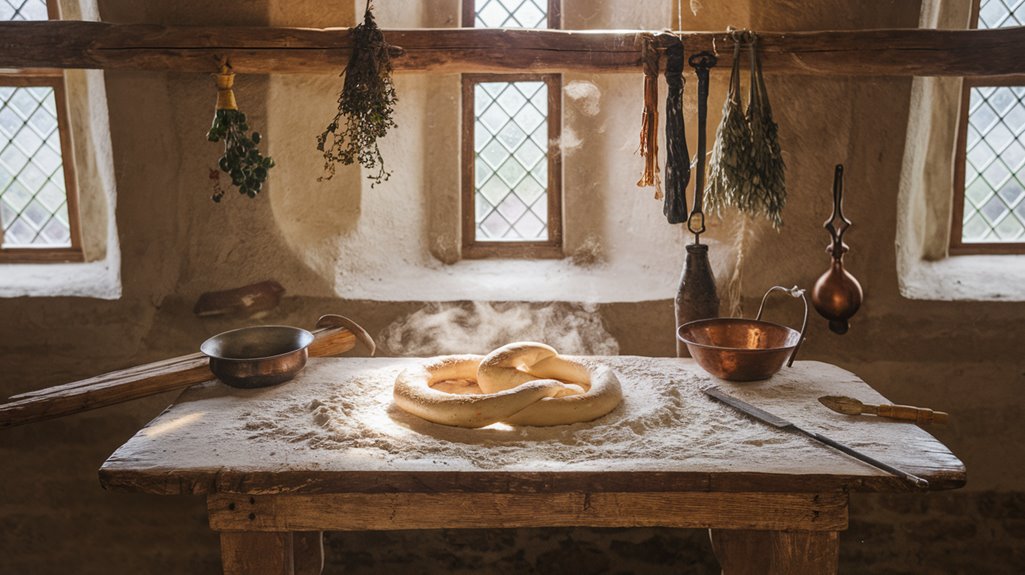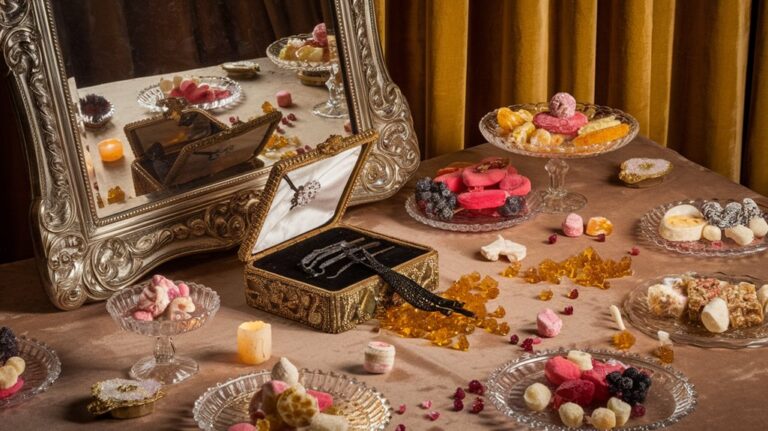Catholic Monks Invented the Pretzel
Picture a medieval monk in a dimly lit monastery kitchen, carefully twisting a rope of dough into the distinctive loops we'd instantly recognize today. You've probably enjoyed pretzels as a salty snack, but you might not know that these twisted treats began as a spiritual creation. In 610 CE, Catholic monks in Northern Italy transformed leftover dough into a meaningful symbol of prayer and faith. There's more to this simple snack's story than its satisfying crunch.
The Origins of Pretzels in Medieval Monasteries
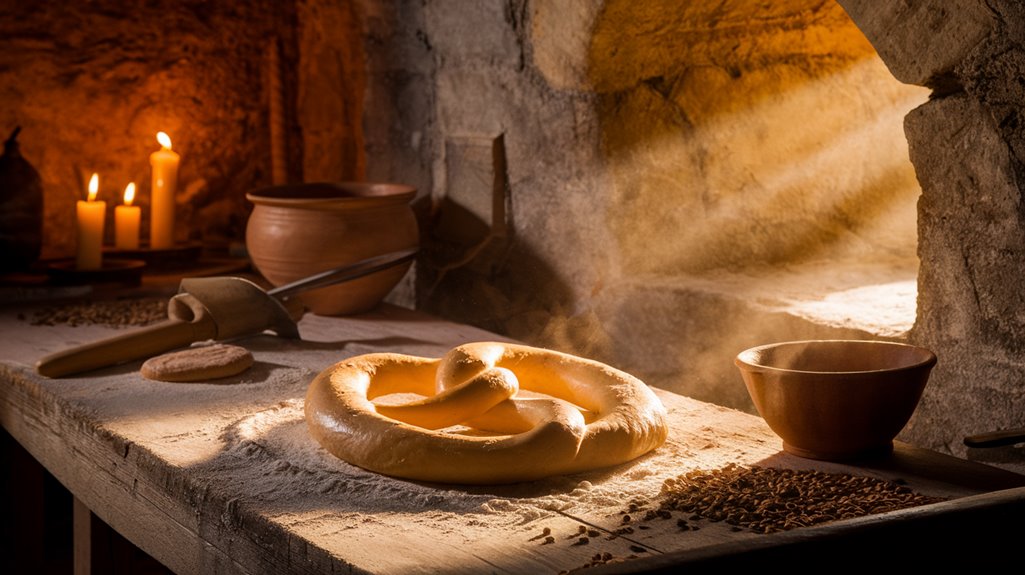
Although the exact birthplace remains debated, pretzels emerged around 610 CE when a monk in Northern Italy crafted the first twisted knot from leftover dough during Lent. This innovative example of monastic baking quickly spread through European monasteries, where monks discovered that the simple combination of flour, water, and salt created the perfect food for fasting periods.
You'll find the pretzel's roots deeply embedded in both Italian and French monastery traditions, where resourceful monks transformed dough leftovers into a shape that represented the Holy Trinity. The twisted design symbolically depicts children's crossed arms in prayer. By the twelfth century, these baked goods had become symbols of German baking.
As the practice spread through religious communities, pretzels evolved from their Roman origins as pretiola bread into a distinct symbol of faith and sustenance. The tradition soon extended beyond monastery walls, gaining popularity throughout Germany and eventually becoming a cornerstone of European baking culture.
Religious Symbolism and Prayer Connections
While many see pretzels as simple snack food today, their religious symbolism runs deep in Christian history. The pretzel's distinctive shape represents children with crossed arms in prayer, while its three holes symbolize the Holy Trinity.
You'll find that even the word "pretzel" itself stems from the Latin "bracellae," meaning "little arms" – a direct reference to prayer traditions.
In medieval times, monks would give these treats to children who memorized their prayers, making pretzel symbolism an integral part of religious education. The Vatican Library's manuscripts document their significance, and Christians often used pretzels during Lent when fasting rules were strict. The tradition originated with Italian monks in 610 A.D. These special breads contained only water, flour, and salt to comply with strict fasting rules.
During this sacred period, families would incorporate special pretzel prayers into their grace, reinforcing the deep spiritual connection between faith and this humble bread.
From Monastic Kitchens to European Markets
Dating back to 610 CE, the humble pretzel emerged from monastic baking kitchens in Italy and France, where monks crafted these twisted treats using basic ingredients of flour, water, and salt.
You'll find that these early pretzels weren't just food items; they served a higher purpose in monastic communities, helping fund religious orders and provide alms for the poor.
As European traditions evolved, you'd see pretzels becoming particularly popular during Lent.
Monks would rise early to bake these prayer-shaped breads, which they'd distribute to school children to help them remember their prayers. The monk's generosity in giving these little rewards called Pretiolas to good students became a cherished tradition.
The practice spread rapidly across Europe, with pretzels becoming so culturally significant that even the renowned astronomer Johannes Kepler referenced them when explaining planetary orbits.
This monastic creation had truly transformed from a simple food item into a widespread cultural phenomenon.
The Legacy of Monk-Made Pretzels in America
As German immigrants settled in colonial America around 1710, they brought with them the cherished tradition of monk-made pretzels, establishing what would become a cornerstone of American snack culture. Early settlers found creative ways to trade, as they bartered pretzels with Native American tribes.
You'll find the pretzel traditions deeply rooted in America's cultural significance, especially in Pennsylvania, where Julius Sturgis opened the first commercial pretzel bakery in 1861. During the era of bars and saloons, pretzels became a popular accompaniment to drinks, cementing their place in American social gatherings.
The monk's legacy lives on through these significant developments:
- The creation of hard pretzels, which transformed from a happy accident into a beloved snack
- The preservation of Christian symbolism, with pretzels still representing spiritual fulfillment
- The evolution from handmade to automated production, while maintaining the traditional pretzel shape that monks originally designed
Today, you'll see this monastic influence in modern pretzel making, as manufacturers continue to honor the religious origins of this timeless snack.
Modern Adaptations of an Ancient Recipe
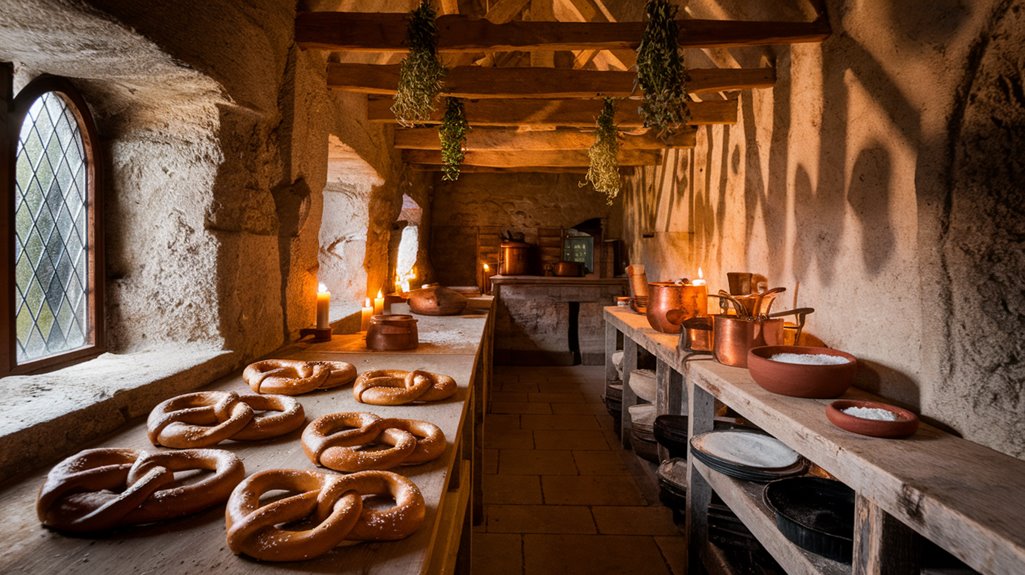
Since medieval times, pretzel recipes have undergone significant transformations in both ingredients and preparation methods.
You'll find that modern pretzel variations differ significantly from their medieval counterparts, particularly in the yeast evolution from beer barm to active dry yeast, and the shift from whole wheat to all-purpose flour.
While ancient bakers shaped their pretzels into a U-shape and twisted them—a technique that's still used today—they didn't use lye for that signature brown crust.
An Italian monk in the seventh century created pretzels as gifts for praying children.
It wasn't until a Munich baker accidentally discovered lye's browning effect that pretzels gained their characteristic golden-brown appearance.
Today, you can achieve similar results using baking soda as a safer alternative. Modern recipes typically require 193 calories per serving, making them a reasonable snack option.
Though preparation times have shortened dramatically, these adaptations haven't diminished the pretzel's deep religious symbolism and traditional significance.

